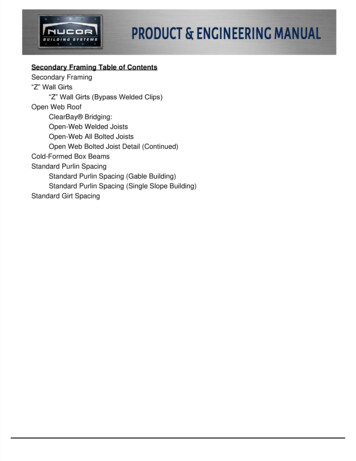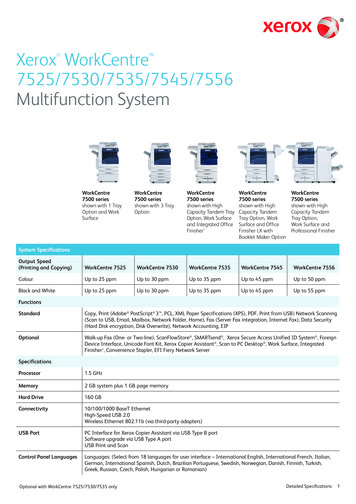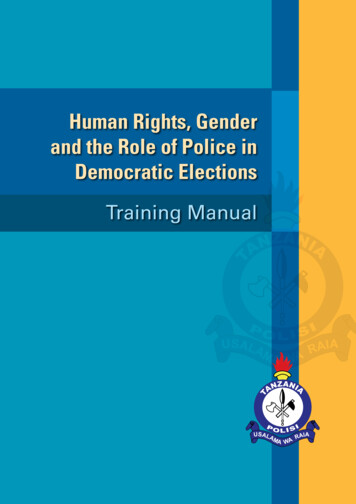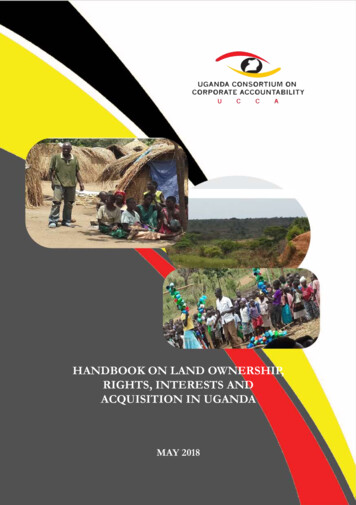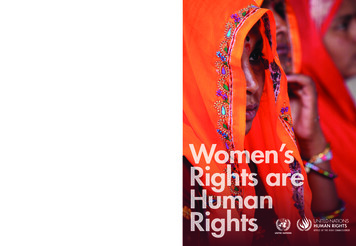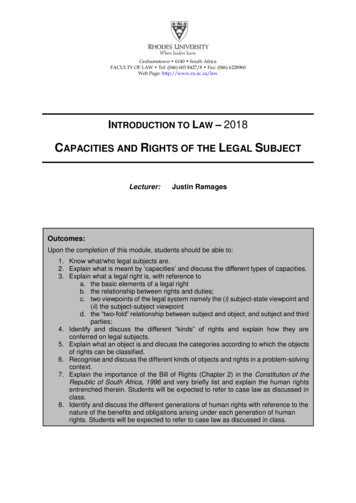
Transcription
Grahamstown 6140 South AfricaFACULTY OF LAW Tel: (046) 603 8427/8 Fax: (046) 6228960Web Page: http://www.ru.ac.za/lawINTRODUCTION TO LAW – 2018CAPACITIES AND RIGHTS OF THE LEGAL SUBJECTLecturer:Justin RamagesOutcomes:Upon the completion of this module, students should be able to:1. Know what/who legal subjects are.2. Explain what is meant by ‘capacities’ and discuss the different types of capacities.3. Explain what a legal right is, with reference toa. the basic elements of a legal rightb. the relationship between rights and duties;c. two viewpoints of the legal system namely the (i) subject-state viewpoint and(ii) the subject-subject viewpointd. the “two-fold” relationship between subject and object, and subject and thirdparties;4. Identify and discuss the different “kinds” of rights and explain how they areconferred on legal subjects.5. Explain what an object is and discuss the categories according to which the objectsof rights can be classified.6. Recognise and discuss the different kinds of objects and rights in a problem-solvingcontext.7. Explain the importance of the Bill of Rights (Chapter 2) in the Constitution of theRepublic of South Africa, 1996 and very briefly list and explain the human rightsentrenched therein. Students will be expected to refer to case law as discussed inclass.8. Identify and discuss the different generations of human rights with reference to thenature of the benefits and obligations arising under each generation of humanrights. Students will be expected to refer to case law as discussed in class.
GENERAL INTRODUCTION:The module “Capacities and Rights of the Legal Subject” is incorporated in the LegalTheory 1 course with the purpose of introducing the concept of “legal rights”. Thefocus of this module will mainly be on the operation of rights between persons. In otherwords, we will discuss the law in the subjective sense as a system of rights and dutiesthat apply to and between legal subjects.1We will begin this module by answering the question of “Who or what is a legalsubject?” We will then discuss the different capacities of legal subjects. The lawprovides legal subjects with certain capacities according to which they are allowed totake part in the legal environment where individuals’ rights are to be respected,protected and promoted. Of course, this has an influence on the relationship betweenlegal subjects, especially with regard to duties that arise by virtue of legal rights. Thediscussion of legal subjectivity and capacities of legal subjects will thus serve asbackground for the discussion of the meaning of “legal rights”.During our discussions of legal rights, we will identify the basic elements of a right. Wewill furthermore address issues such as the extent and enforcement of rights. Differentkinds of rights will be identified and explained in terms of both the private and publiclaw spheres. In terms of the private law sphere we will examine the different kinds ofsubjective rights. In terms of the public law sphere we will discuss human rights withspecific reference to the Bill of Rights contained in chapter 2 of The Constitution of theRepublic of South Africa of 1996.During lectures, reference will be made to case law as part of the discussion of thework. These cases must be referred to and applied in assignments, tests andexamination answers.1Kleyn D, Viljoen F Beginner’s Guide for Law Students 3ed (2004) 112-113 (Juta Law, A Division of Juta& Co, Lansdowne,SA).Hereafter ‘Kleyn and Viljoen’.Page 2 of 16
AWHO OR WHAT IS A LEGAL SUBJECT?The term “legal subject” can be defined as a bearer of juristic competencies, subjectiverights (with the inherent powers or entitlements) and legal duties.2 In South African lawthere are two categories of legal subjects: (i) natural persons and (ii) juristic persons.All human beings are referred to as natural persons and are thus legal subjects.Juristic persons, however, can be defined as certain associations of natural persons,such as companies and universities. 3 They are viewed as entities and are alsoconsidered to be “persons” and thus legal subjects in terms of the law.BCAPACITIES OF LEGAL SUBJECTSThe law provides legal subjects (the bearers of rights and duties) with the ability(capacity) to participate in legal activities.4 The content and purport of a legal subject’scapacities is very important since it determines the subject’s status, and thereforeextent of participation, in the legal system.5Not all legal subjects have the exact same capacities. There are four different types ofcapacities that legal subjects can have.1. The first type, called legal capacity, can be described as a legal subject’s abilityto bear rights and duties. 6 It is therefore essentially the same as legalsubjectivity, because it is acquired through being a person. In other words, alllegal subjects have legal capacity simply because they are recognised by thelaw as “persons with rights and duties”.2. The second type, capacity to act, refers to a legal subject’s ability to performjuristic acts. Juristic acts are purposeful lawful acts to which the law attachesthe consequences envisaged by the party or parties who performed them.Juristic acts create, amend and terminate rights and duties. Examples of juristicacts are the conclusion of a contract, the making of a will, the entering into amarriage etc. Contrary to the situation with legal capacity (where all legalsubjects share the same capacity), not all legal subjects have the samecapacity to act. Depending on factors such as a person’s age, mental health,2 DavelCJ, Jordaan RA PersoneregStudentehandboek 2ed (1998) 3 (Juta& Co, Lansdowne, SA).Hereafter Davel andJordaan.3Kleyn and Viljoen 113.4 Legal activities include the making of a will, entering into a contract, getting married, the setting up of a company etc.5Davel and Jordaan 1.6Kleyn and Viljoen 113.Page 3 of 16
financial solvency etc, a person can have the capacity to act in terms of threecategories:a. No capacity to act:Persons that fall into this category cannot perform a legally valid juristicact. Children under the age of seven (infantes) and insane persons areexamples of legal subjects with no capacity to act.b. Limited capacity to act:Some legal subjects do not have the capacity to perform legal actsunless assisted by someone designated by the law. For example, acompany cannot hire a new secretary by itself since it is merely anabstract entity. It has to be represented by people who are designatedto hire new staff on behalf of the company.c. Full capacity to act:People with full capacity to act can perform all juristic acts themselves.People over the age of 18 and emancipated minors are presumed tohave full capacity to act.3. Locus standi in iudicio is the third type of capacity. This entails the capacity tobe a party in court proceedings (for example the plaintiff or defendant). Althoughnot all legal subjects can exercise their locus standi in iudicio by themselves, itdoes not mean that they are without this capacity. 7 Persons who cannotparticipate as a party themselves are usually assigned a curator personae,bonae or ad litem to represent them as parties in a trial.4. Accountability is the capacity to be held accountable (or liable) for unlawful acts.It concerns the ability to distinguish between right and wrong8 and to conductone’s actions accordingly. Persons who do not have this ability are consideredto be doli incapax.In terms of the above explanations of legal subjectivity, capacity and the four kindsof capacities, it is clear that all legal subjects have rights, but depending on theircapacities, the content of their duties may vary.Du Plessis L An Introduction to Law 3ed (1999) 137 (Juta& Co Ltd, Kenwyn). Hereafter ‘Du Plessis, An Introduction toLaw’8Kleyn and Viljoen 115.7Page 4 of 16
CRIGHTS IN CONTEXT1. Introduction:Before we go on to the discussion of what legal rights entail, it is necessary to placerights (and their correlating duties) into context. Rights and duties exist within thecontext of a legal system where legal subjects interact with one-another and with theState (Government). There are two aspects, or viewpoints, of a legal system that areimportant to keep in mind when we deal with rights and duties.9The first aspect is the relationship between the subjects and the State (the subjectstate relationship). This relationship can be described as a vertical relationshipbecause the government or state authority is appointed “over” the people to enforcethe law. It can furthermore be described as being unequal in the sense thatgovernment has more power than its subject(s).10 It is thus a relationship governed interms of public law. Rights in the public law sphere are referred to as human rights.The second aspect is the relationship between the subjects of a society (the subjectsubject relationship).This relationship can be described as horizontal, because it ismostly constituted by interaction between persons (among each other) mostly on anequal basis. The subject-subject relationship can fall in the spheres of both privatelaw, where the rights of a legal subject are called subjective rights, and public law(human rights).In what follows, we will discuss the basic elements of rights (and duties) and we willidentify and discuss different kinds of rights.DTHEBASICELEMENTSOF ARIGHT – ILLUSTRATINGTHE RELATIONSHIP BETWEENRIGHTS AND DUTIESA (legal) right is an interest conferred and protected by the law to the benefit of rightholder. 11 The existence of a right presupposes two relationships: (i) a relationshipbetween the legal subject and a legal object, and (ii) a concurrent relationship betweenthe legal subject and other legal subjects (private law) or the state (public law).12 ThisDu Plessis, An Introduction to Law 138.In terms of this aspect the importance of human rights is evident. Since the State has more power, it is necessary thatthe subjects are protected from unjust State conduct. See below the notes on human rights.11Hutchinson D Wille’sPrinciples of South African Law 8ed (1991) 38.12Kleyn and Viljoen 116.910Page 5 of 16
two-fold relationship will be further illustrated and explained in the discussion ofsubjective rights below.There are 6 basic elements of legal rights which illustrate the correlation betweenrights and duties, as well as the relationships that are present when a legal right exists.These elements are:1. A title which gives rise to or confers the right – i.e. the fact or event that veststhe right in the subject of the right.2. The presence of a subject of the right – i.e. a person who holds the right.3. The inherent power conferred on the subject of the right with regard to the objectof the right.4. The object of the right – i.e. the thing to which the right relates.5. The presence of a subject of the duty – i.e. a person who is under an obligationin terms of the correlating right.6. The corresponding duty – i.e. the obligatory conduct of the subject of the duty.ETHE CLASSIFICATION OF LEGAL OBJECTS AND SUBJECTIVE RIGHTS1. Legal ObjectsLegal objects are ‘things’ with value in which legal subjects can acquire rights. In otherwords, when a legal subject has a right to something (the legal object), there is a legallyprotected relationship between the subject and the object to the extent of theentitlement. Legal objects can be divided into the following different categories.(a) Corporeal Things“Things” are concrete and tangible objects such as a motor car, money, cattle,furniture, a house, etc.13 Things are subdivided into two categories, namely (i) movablethings and (ii) immovable things. Ownership of movable things are transferred bydelivery of the thing, while ownership of immovable things are transferred byregistration in the deeds office in the name of the new owner.141314Du Plessis, An Introduction to Law 138.Du Plessis, An Introduction to Law 138.Page 6 of 16
(b) PerformancesA performance is an act by someone else, which can amount to giving something(dare), doing something (facere) or not doing something (non facere).15 Usually,contracts or delicts give rise to obligations to give, do or not do something.16(c) Intellectual (immaterial) PropertyThe term “intellectual property” refers to creations of the human mind. 17(d) Aspects of PersonalityA legal subject’s reputation or good name (fama), dignity, honour or self-worth(dignitas) and physical integrity (corpus) are all aspects of that legal subject’spersonality.18(e) Personal Immaterial Property (?)According to Neethling, there is a fifth category of legal objects that pertain to a legalsubject’s ability to earn or to be creditworthy. 192. Subjective Rights:(a) A Two-fold Relationship:A subjective right can be defined in terms of a twofold relationship. On the one hand,it is a “legally supported claim by a legal subject to a legal object by virtue of which thesubject acquires particular powers regarding the object” (i.e. the subject-objectrelationship), and on the other hand, it is “a relationship between the subject and thirdparties by virtue of which the third parties are legally obliged to respect the subject’sclaim to the object”20 (i.e. the subject-third parties relationship).(b) Patrimonial and Non-patrimonial Rights:All subjective rights can be identified as either patrimonial or non-patrimonial rights.21Patrimonial rights are those rights which have objects with a determinable monetaryDu Plessis, An Introduction to Law 138. See also Kleyn and Viljoen 116.and Viljoen 116.17 Du Plessis, An Introduction to Law 138. See also Kleyn and Viljoen 117.18 Du Plessis, An Introduction to Law 138. See also Kleyn and Viljoen 117.19 Du Plessis, An Introduction to Law 145. See also Kleyn and Viljoen 117.20 Du Plessis, An Introduction to Law 140.21 Du Plessis, An Introduction to Law 145.1516KleynPage 7 of 16
or material value. Non-Patrimonial rights are those rights with objects that are ofsentimental value only.22(c) Absolute and Relative Rights:To determine whether subjective rights apply absolutely or relatively regard must behad to a difference in operation of rights. While an absolute right prevails againsteveryone, a relative right only prevails against a particular person (debtor). Anexample of an absolute right is the right of ownership (see the discussion of real rightsbelow). An example of a relative right is a personal right (see the discussion ofpersonal rights below).3. Kinds of Subjective Rights:Rights are classified in terms of the objects that they relate to. Therefore the type ofsubjective right that an individual has in a particular instance depends on the object ofthat subjective right. The classification of subjective rights into categories thuscorrelates with the categories of legal objects and can be identified as follows:a. Real Rights:Prescribed Case Law:Kain v Kahn 1986 (4) SA 251 (C)Real rights are rights with respect to things.23 The branch of private law that regulatesthe law regarding real rights (and things) is called property law. Ownership of property(ius in re sua) is the most comprehensive right because of the nature of the conceptof “ownership”. All other real rights are limited rights in the sense that they are “rightsto the things of others” (ius in re aliena).24There are two ways in which one can acquire real rights. The first is original acquisitionand the second is derivative acquisition.i. Original Acquisition:Original acquisition of real rights takes place when there is no previous owner of thethings which is to be acquired, or where a previous owner need not co-operate in thetransfer of the right. In situations where there is no previous owner, real rights areDu Plessis, An Introduction to Law 145.Du Plessis, An Introduction to Law 142. See also Kleyn and Viljoen 117.24 Du Plessis, An Introduction to Law 142.2223Page 8 of 16
acquired by means of occupatio. This means that ownership is acquired throughappropriation, i.e. by taking physical control of a previously unowned thing with theintention of becoming the owner.25 In situations where there was indeed a previousowner, the acquisition of a real right can take place by means of accessio or by meansof prescription. Accessio takes place when two corporeal things are combined in sucha way that one thing (the accessory thing) becomes a component of the other (theprincipal thing).26 Prescription is the process whereby rights are acquired (acquisitiveprescription) or lost (extinctive prescription) by the lapse of time. Acquisitiveprescription takes place if a person possesses an object openly as if she were theowner thereof for an uninterrupted period of 30 years.27ii. Derivative Acquisition:Derivative acquisition takes place when an owner of a thing agrees to transferownership or some other real right to another person. In the case of movable things,a transfer of rights occurs once possession of the thing is delivered from the transferorof the right to the transferee of the right. The requirements for possession is, first, thatone must have physical control of the thing (detentio) and, second, that one must havethe intention to hold the thing for one’s own benefit (animus possedendi). Possessionfurthermore has two elements: a mental element and a physical element. The mentalelement of possession is established by agreement between the parties. The physicalelement of possession can be established by either actual or constructive (or fictitious)delivery. Actual delivery simply entails the actual handing over of the thing to thetransferee. Constructive delivery takes place when, although a thing is not (or cannotbe) moved from one person to another, the circumstances are such that the control ofthe thing nevertheless vests in the transferee.The transfer of a real right in immovable things occurs through the registration of thetransfer in the Deeds Office in the name of the new owner.b. Personal Rights:A personal right can also be referred to as a right of performance or a legal claim.Personal rights are thus rights with respect to performances by third parties. Personalrights differ from the other categories of rights in the sense that the twofold relationship25Vander Walt AJ, Pienaar GJ Introduction to the Law of Property 3ed (1999) 113.Hereafter Van der Walt and Pienaar.der Walt and Pienaar 116.27Van der Walt and Pienaar 131.26VanPage 9 of 16
between subject-object and subject-and-third parties is somewhat intertwined. Thisfollows from the fact that the performance to which the subject has the claim isdependent upon the performing of the third party. In other words, it can be argued thatthe subject has a claim against the third party to perform. Note that the subject doesnot have a claim on the debtor as person – persons are not legal objects. Thedifference between a real right and a personal right is that with real rights one has aright to “that which is mine”, and with personal rights one has a right to “that which isdue to me.”28The following are examples of how personal rights may be acquired:i. Contract: A contract is an agreement entered into with the intention ofcreating legal obligations.29 People enter into contracts to create legallybinding rights and duties. A valid contract therefore creates personalrights.ii. Delict: Rights and obligations in terms of delicts (unlawful acts) arisethrough the operation of the law. A delict is a wrongful act committed bya person who causes harm to another person or to their property. Interms of delicts a personal right to be compensated by the wrongdoer forthe harm and/or damage done is conferred and protected by the law.iii. Judgment of a Court: In criminal court cases, where a person was foundguilty of a crime, a personal right is conferred on the State for examplethe payment of a fine. In civil cases a personal right is conferred on thesuccessful party.iv. Legislation: Statutes can place obligations on legal subjects. Exampleswill be given in class.c. Intellectual Property Rights:As mentioned earlier intellectual property are the products of creative human skill.Intellectual property rights are acquired with the creation of intellectual property andentails that others have a duty to refrain from any infringement on the rights.d. Personality Rights:2829Du Plessis, An Introduction to Law 147.Christie RH Contract in JA Joubert (Ed) LAWSA Vol 5 (1) (1994) par 124.Page 10 of 16
As mentioned earlier under the discussion of aspects of personality, personality rightsentail a person’s right to a good name, dignity and physical integrity. People have theduty to refrain from infringing on the fama, dignitas and corpus of one another.e. Personal Immaterial Property Rights: (?)Personal immaterial property rights entail the duty to refrain from conduct that infringesupon, or negates a legal subject’s personal immaterial property, such as the ability toearn.Table 1Legal ObjectLegal SubjectExampleThingReal RightOwnership (rights)PerformancePersonal RightDelictIntellectual PropertyIntellectual Property RightCopyrightAspects of PersonalityPersonality RightRight to a good name(Personal Immaterial(Personal ImmaterialProperty)Property Rights)Page 11 of 16(Right to earn an income)
FHUMAN RIGHTS1. Introduction:Human rights stem from the principle that each human being has inherent dignity dueto the fact of their “humanness”. Kleyn and Viljoen30 refer to the inherent dignity interms of our “humanness” as “the core of humanity”. It may not be infringed upon andit must be respected, protected and promoted by everyone.Human rights are used in the public law sphere to protect individuals from State powerin particular. Given the extensive scope of government authority, there must be madeprovision for the protection of the fundamental rights of the State’s subjects.31 In SouthAfrica, provision for the protection of human rights is made by including a Bill of Rightsin Chapter 2 of our supreme law, the Constitution.32The implication ofconstitutionalism is that everyone in South Africa, including government, must respect,protect and promote human rights in line with the constitutional values of humandignity, equality and freedom.332. International recognition of Human RightsAfter the gross violation of human rights during the Second World War, it became clearthat the protection of human rights in terms of international law has become anecessity. Subsequently, many countries entrenched human rights in theirconstitutions to ensure the protection of human rights. The international communityresponded to the need to protect human rights by the founding of the United Nations(UN) in 1945 with the purpose to promote international peace and to protect humanrights. In 1948 the UN adopted the Universal Declaration of Human Rights, which liststhe basic rights of each individual throughout the world. In 1966 the Declaration ofHuman Rights was supplemented by the International Covenant on Economic, Socialand Cultural Rights and the International Covenant on Civil and Political Rights.Conventions aimed at the protection of specific groups of people have also beeninstituted by the UN. In 1979 the UN adopted the Convention on the Elimination of all30Kleynand Viljoen 244.Plessis L Introduction to Law 158.32The Constitution of the Republic of South Africa of 1996.Hereafter ‘the Constitution. In s 2 explicitly confirms that theConstitution is the supreme law and that any law or conduct inconsistent with it is invalid.33Section 1 of the Constitution.31DuPage 12 of 16
Forms of Discrimination against Women and in 1989 the UN approved theInternational Covenant on the Rights of the Child.34Regional systems developed to protect human rights in certain regions. In Europe,almost all the states ratified the European Convention on Human Rights of 1950. InSouth, North and Latin America the so-called Inter-American system was developed.In Africa the Organisation of African Unity adopted the African Charter on Human andPeoples’ Rights in 1981.Although there are International and Regional recognition and protection of humanrights, the infringement of rights are in the first instance to be addressed in the countrywhere it happened. It makes sense for practical reasons, but there are also PublicInternational Law issues involved. Although countries/states are part of aninternational community where there are shared interests, every state has sovereignpower within its own territory which has to be respected. For example, the rightsviolations in South Africa during the Apartheid era were not directly and summarilystopped by the international community, because the South African governmentclaimed that it was an internal (or domestic) issue. The international communityexpressed their disapproval in a less direct manner by the implementation of sanctionsagainst South Africa’s participation in or at certain international occasions (like theOlympic Games). The disapproval of the international community expressed in thatway has put much pressure on the South African government to review their politicalorientation. Fortunately, South Africa became a democratic state with a system ofConstitutionalism in 1994. This lead to the entrenchment of the Bill of Rights that giveshuman rights in South Africa the status of supreme law.3. The Constitution and the Bill of RightsThe Constitution consists of 14 chapters with 243 sections all-in-all. Chapter 2 containsa list of human rights and is known as the Bill of Rights. Although we are mainlyconcerned with the Bill of Rights for purposes of this module, we can only understandthe Bill of Rights as a part of the Constitution as a whole.35 The Bill of Rights shouldthus always be read and interpreted in the context of the Constitution as a whole, andthe principles of democracy and constitutionalism must be borne in mind.34Kleynand Viljoen 245-246.Currie I, De Waal J The Bill of Rights Handbook 5ed (2006) 1 (Juta& Co, Wetton, SA). Hereafter ‘The Bill of RightsHandbook’.35Page 13 of 16
The Bill of Rights contains sections 7-39 of the Constitution. Sections 8, 36-39 do notcontain rights. They are operational provisions. Section 8 deals with the application ofthe Bill of Rights. Section 36 is known as the ‘limitation clause’ since it regulates thelimitation of rights in specific circumstances. According to s 37 a state of emergencymay be declared under exceptional circumstances, in which certain rights may besuspended for the duration of the emergency. Section 38 makes provision for theenforcement of human rights in that legal subjects may approach a competent courtto enforce their rights. The last section in the Bill of Rights, s 39, contains provisionsregarding the interpretation of the Bill of Rights. The content of these operationalsections will be discussed in more detail during lectures.Below is a list of the rights that are contained in the Bill of Rights. The rights that areunderlined will be the focus point for this course.NOTE: There is no hand-out material for these underlined rights. The Constitutionshould be considered your source because all these rights are contained in theBill of Rights. The prescribed case law for the Human Rights section is: Soobramoney v Minister of Health (Kwazulu-Natal) 1998 (1) SA 765(CC), and Christian Lawyers Association of SA v Minister of Health 1998 4 SA1113 (T). The PowerPoint presentations used during lectures will be the only additionalsource of information (apart from the Constitution) regarding these underlinedrights.1. Section 9 – Equality2. Section 10 – Human Dignity3. Section 11 – Life4. Section 12 – Freedom and security of the person5. Section 13 – Slavery, servitude and forced labour6. Section 14 – Privacy7. Section 15 – Freedom of religion, belief and opinion8. Section 16 – Freedom of ExpressionPage 14 of 16
9. Section 17 – Assembly, demonstration, picket and petition10. Section 18 – Freedom of Association11. Section 19 – Political Rights12. Section 20 – Citizenship13. Section 21 – Freedom of Movement and Residence14. Section 22 – Freedom of trade, occupation and profession15. Section 23 – Labour relations16. Section 24 – Environment17. Section 25 – Property18. Section 26 – Housing19. Section 27 – Health care, food, water and social security20. Section 28 – Children21. Section 29 – Education22. Section 30 – Language and Culture23. Section 31 – Cultural, religious and linguistic communities24. Section 32 – Access to information25. Section 33 – Just administrative Action26. Section 34 – Access to courts27. Section 35 – Arrested, detained and accused persons4. Generations of Human Rights36Human rights are divided into three categories. These categories are called‘generations’.a. First Generation Rights:These rights are also known as civil and political or ‘blue’ rights. It provides a shieldfor legal subjects to protect themselves against unlawful interference by the state.These rights are a means of limiting state power and fostering democracy by providingprotection against oppressive rule. These rights impose a duty on the state to refrainfrom doing things of an oppressive nature. First generation rights are directlyenforceable against the state. Examples of first generation rights are the rights to36Kleynand Viljoen 247.Page 15 of 16
equality (s 9), life (s 11), privacy (s 14), freedom of religion, belief and opinion (s 15)and freedom of expression (s 16).b. Second Generation Rights:These rights are also known as socio-economic rights, aspirational rights or ‘red’rights. Rather than requiring the state to refrain from acting, these rights actually obligethe state to take positive action. Rights in this category act as a sword in the hand ofindividuals compelling the state to distribute its resources in a just and equitablemanner so as to benefit all members of society. Second generation rights are oftenregarded as being “aspirational” because they are not always directly enforceableagainst the state. This is because the enforceability of this genera
rights and duties, as well as the relationships that are present when a legal right exists. These elements are: 1. A title which gives rise to or confers the right – i.e. the fact or event that vests the right in the subject of the right. 2. The presence of a subject of the right





